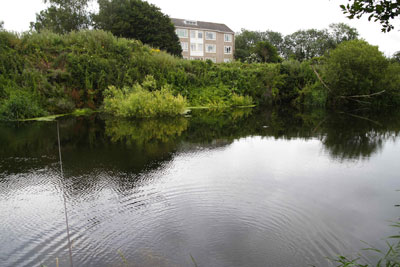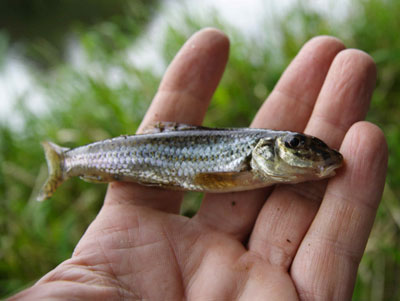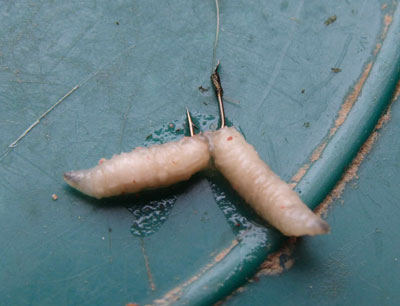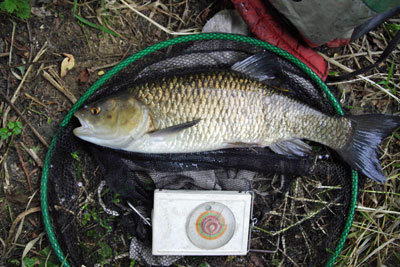I’m not talking about stalking fish with a single large bait but much more conventional trotting where there is a strong tradition of using loose feed or groundbait.
When I started fishing as a whipper-snapper forty years ago my simple tactics were float-fished bread paste or worms, and occasionally legered worms. Such tactics brought dace, trout and occasional roach from the nearby Dorset Piddle. It was only when, with more pocket money, I bought maggots that I could afford to trickle in some loose feed to attract more fish. In the decades that followed, I learnt plenty from extensive match fishing where it is common, especially when dace fishing on a fast river, to have to compete for your fish with other anglers, and where your feeding mistakes are punished by your losing the fish.

But over the last couple of years, I have found myself grabbing a simple kit that allows me to snatch a couple of hours fishing on the nearby Dorset Stour. Initially, my thoughts turned towards trying to tempt big perch so bait requirements have been a match pack of dendrabenas. My tactics have been to floatfish with an Avon float using a couple of worms on a size 10 or 8. I’ve certainly caught plenty of perch though nearly all small ones. This was expected but the bonus has been a surprising number of roach that nibble away until they manage the worm, some nice dace, small chub and the occasional big chub to well over five pounds.

Fishing with worms is a tactic that I’ll continue to use when I feel so inclined but it was recent trip that really had me thinking. Although I had some worms I decided to try fishing with maggots on the same stretch where I’d previously tried worms. The major snag with maggots on the Dorset Stour in summer is bleak and minnows. Accepting that the experiment might be a disaster I took back-up bait of worms. Early season the minnows are not too active but to beat the bleak I used a medium Avon float taking a bulk of 7BB with some small shot below the bulk. A size 18 hook completed the rig.
Now for the tactical experiment. It’s clear that any loose feed quickly draws the bleak to the point that getting past them is a nightmare, even with heavy bulk shotting. I had a small amount of maggots and had no intention of trying to feed off the bleak, which would take half a gallon at least. Instead, I decided not to feed at all. The only maggots in the swim would be those on my hook.

The swim is the tail end of a long glide before some weedy shallows. The river is around twenty yards wide here with a sunken tree opposite the fishing spot. There is a slack behind the tree that holds plenty of perch. There are roach, dace, perch and chub, as well as the tiddlers like bleak, minnows and gudgeon. Setting the float to seven feet meant that it only dragged under where the weed started. It wasn’t long before I started to get bites. I couldn’t entirely avoid the bleak but mostly I caught small roach of a couple of ounces and perch around six ounces which put up a spirited fight. A jack pike chased a couple of fish before successfully snatching one of the perch, after which it didn’t bother me again. Mostly I cast slightly downstream to the middle of the river but when the bleak were too troublesome I’d cast another five yards downstream. The disturbance of the float hitting the water obviously attracted the bleak.
After an hour and about a dozen fish aside from bleak, I decided to try a cast to run alongside the sunken tree. The float cocked, settled, I trimmed the line and the float sank out of sight. A gentle strike and I was quickly left in no doubt that I’d hooked something much bigger. Although I was using a hook to nylon tied back in the 70’s (I chuck all sorts of old bits and bobs into my roving bag!) I had confidence in Bayer 1.7 even if it was 30 years old. The chub put up a stubborn fight but I was never in real danger of losing it despite the nearside reeds or sunken tree. Whilst playing it I was under the impression that it was a middleweight of two or three pounds but when I drew it over the net, I realised that it was somewhat bigger. At 5-08 it’s my best chub so far this season not that I’ve spent much time pursuing them.

After that bit of excitement, I had some more perch and roach before the swim died. As an experiment, I tried another swim at the top end of the glide but this time feeding 30 or 40 maggots every cast. Although I had a quick couple of roach and perch, the swim quickly became unfishable as the bleak and minnows (which had not bothered me at all in the other swim) took over.
My conclusion from this is that this tactic is worth a try on minnow/bleak infested waters from time to time. It is true that other summer baits – perm any from casters, hemp, tares, sweetcorn, worms, pellets – may often work better but there are times when maggots are a very good bait in summer provided you can fish them in a way that doesn’t every tiddler for a hundred yards. I’ve mentioned using worms and there’s no reason why you shouldn’t try flake as well. I have had success in a similar vein in a match when feeding casters extremely sparingly, just two or three at a time, so that the dace out-competed the minnows.










